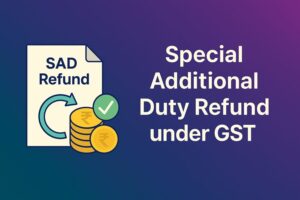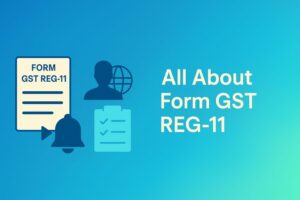Time Limit for Issue of Invoices Under GST
- 28 Nov 24
- 8 mins

Time Limit for Issue of Invoices Under GST
Key Takeaways
- A tax invoice is essential for documenting transactions and claiming Input Tax Credit (ITC).
- GST invoices must include details like supplier/recipient info, HSN/SAC codes, and tax amounts.
- For goods, invoices are issued at removal, delivery, or approval, depending on the supply type.
- Service invoices must be issued within 30 or 45 days, based on service type and payment terms.
- Timely invoicing ensures compliance, avoids penalties, and supports smooth ITC claims.
Under the regime of Goods and Services Tax (GST) in India, issuing invoices within a specific timeframe is an important compliance requirement for businesses. The law of GST specifies deadlines for tax invoice issuance to maintain accurate documentation for both businesses and consumers.
These time limits vary, depending on the type of supply and whether it is for the supply of goods or services.
In this blog, we will discuss the time limit for the issue of invoices under GST for goods and services, while highlighting the definition of a tax invoice, the details required in an invoice, and many more.
What Is a Tax Invoice?

A tax invoice is a primary document that outlines the details of a transaction. It consists of essential details of sold goods, like the applicable taxes, quantity, and taxable value. It serves as proof of the time of supply, which enables input tax credit claims for consumers. In India, a supplier must issue a tax invoice to a consumer on account of the sale of goods.
The GST Law defines a tax invoice as ‘a document issued by an input service distributor (ISD) which will also include any additional supplementary or revised invoice issued by a supplier, regarding a previous supply that was made.'
An original GST invoice must include:
- It is an essential document which a supplier of services issues.
- Any concept-revised invoice or supplementary invoice which a registered person issues for some previous supplies.
Who Should Raise Invoices?
Any supplier of taxable goods needs to issue an original GST invoice at the time of the sale of goods. The invoice should consist of the product description, value of the products, quantity, and tax liability.
GST receipt voucher needs to be issued during the receipt of advance payment for goods or services. In case a supplier of services does not deliver in return for the advance payment, it leads to the issuance of a refund voucher.
Details Required in a Tax Invoice
Following are the GST invoice rules which are required:
- A supplier's name, GSTIN and address
- Unique serial number which consists of only numerals and/or alphabets
- Date of invoice issuance
- Recipient's name, GSTIN and address
- Description of the product and/or service
- SAC of services or HSN Code of goods
- Unique Quantity Code and quantity of goods
- Valuation of goods and/or services
- Applicable tax rate (CGST, SGST, IGST)
- Value of discounts after deduction of discount, if any
- State name and the place of supply for inter-state supplies
- The total amount of tax payable
- Place of delivery if it is not the same as place of supply
- Applicability of reverse charge
- Mention of ‘supplementary invoice’ or ‘revised invoice’ along with the original invoice’s invoice number and date
- Supplier's applicable signature or digital signature
- The invoice number, which needs to be a combination of numbers, alphabets and special characters.
Details Required for Tax Invoices for Exports
In the case of invoice for export supplies, the export invoices must include the following details:
- Supplier’s Credentials: Name, address and contact details of the supplier for proper identification
- Buyer’s Credentials: Name, address of delivery and contact details of the buyer
- Details of the Goods or Services: Information on the services or goods, quantities of goods, total amount, applicable rate of tax
- Supplier’s GSTIN: Unique identification number, which is allotted to every taxable person
- Invoice Date: Date of export invoice generation
- Invoice Number: Unique alpha number for recording and tracking transactions
- Conversion Rate: Mention currency conversion when you are dealing with other currencies than the Indian rupee, especially in the case of export transactions
- Total Amount: Total value of the business transaction which includes freight, insurance and various taxes
- Export Type: The invoice should contain details of the type of export. For example, if the export was conducted after payment of taxes (IGST) or under a letter of undertaking to a SEZ.
- Shipping Bill Details: You need to file a document with Customs, consisting of the value and type of goods you intend to export.
- Signature: The digital or physical signature of the supplier is essential to check the authenticity of the transaction.
- Additional Note: The invoice must also consist of any additional charges, information, or remarks for the importer from the supplier.
Time Limits for Issuance of Tax Invoices
The prescribed time limits for issuing a tax invoice depend on the type of case– normal or continuous supply of services.
- Normal Case: In case there is movement of goods, the issue of tax invoice must be from the location of the supplier to the buyer’s location, on or before goods removal. In case the taxable supply does not involve the movement of goods, the supplier needs to issue the invoice on or before the time of delivery of goods.
- Continuous Supply of Goods/Services: For a continuous supply of goods/services where there are successive payment statements or accounts, you need to issue the invoice before or at the time of each payment.
Take a look at the table below to understand the time limits for issuance of tax under different circumstances:
Case 1: Supply of Goods

| Description | GST Invoice Issuance |
| No movement of goods | You need to issue a GST invoice during the delivery of goods. |
| There is the movement of goods | You need to issue a GST invoice during or before the time of removal of goods. |
| When you issue goods on an approval basis or a sale | You need to issue GST at one of these two events, whichever is earlier: before the time of supply, at the time of supply or 6 months from the date of removal |
| When there is a continuous supply of goods | You need to issue a GST invoice during the time or before each receipt of payment or statements of accounts issuance. |
Case 2: Supply of Services
| Description | GST Invoice Issuance |
| For every kind of supply of services, excluding suppliers of insurance and banking services | You need to issue a GST invoice within 30 days from the supply of service date |
| Supply of insurance or banking services | You need to issue a GST invoice within 45 days from the supply of service date |
| When there is a continuous supply of services: | |
| When the payment due date is known during the time of the service contract | On or before the supply of service due date |
| The payment due date is not known during the service contract time | Before or at the payment receipt time |
| Connection of the payment with an event completion | Before or on the completion of the event |
Conclusion
Adhering to the time limit for the issue of invoices under GST for goods and services is crucial for maintaining compliance and avoiding hefty penalties for issuing false invoices. Timely invoicing not only ensures smooth tax credits for recipients but also avoids financial risks for suppliers. Furthermore, it helps increase transparency in tax reporting.
💡If you want to streamline your payment and make GST payments, consider using the PICE App. Explore the PICE App today and take your business to new heights
 By
By 

















